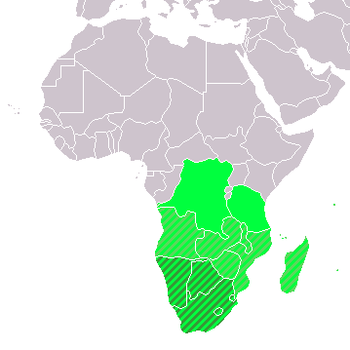Southern Africa
This is Wikipedia's current article for improvement – and you can help edit it! You can discuss how to improve it on its talk page and ask questions at the help desk or Teahouse. See the cheatsheet, tutorial, editing help and FAQ for additional information. Editors are encouraged to create a Wikipedia account and place this article on their watchlist. |

Southern Africa is the southernmost region of the African continent, variably defined by geography or geopolitics. Within the region are numerous territories, including the Republic of South Africa; nowadays, the simpler term South Africa is generally reserved for the country in English.[1]
Definitions and usage
UN scheme of geographic regions and SACU
In the UN scheme of geographic regions, five countries constitute Southern Africa:[2]
The Southern African Customs Union (SACU), created in 1969, also comprises the five countries in the UN subregion of Southern Africa.[3]
SADC membership
The Southern African Development Community (SADC) was established in 1980 to facilitate co-operation in the region. It includes:[4]
 Angola
Angola Botswana
Botswana Democratic Republic of the Congo
Democratic Republic of the Congo Lesotho
Lesotho Madagascar
Madagascar Malawi
Malawi Mauritius
Mauritius Mozambique
Mozambique Namibia
Namibia Seychelles
Seychelles South Africa
South Africa Swaziland
Swaziland Tanzania
Tanzania Zambia
Zambia Zimbabwe
Zimbabwe
General usage
The region is sometimes reckoned to include other territories:
 Angola – part of Central Africa in the UN scheme.
Angola – part of Central Africa in the UN scheme. Comoros,
Comoros,  Madagascar,
Madagascar,  Malawi,
Malawi,  Mayotte,
Mayotte,  Mauritius,
Mauritius,  Mozambique,
Mozambique,  Réunion,
Réunion,  Seychelles,
Seychelles,  Zambia,
Zambia,  Zimbabwe – part of Eastern Africa in the UN scheme.
Zimbabwe – part of Eastern Africa in the UN scheme.
The Democratic Republic of the Congo and Tanzania, though more commonly reckoned in Central and Eastern Africa respectively, are occasionally included in Southern Africa.
Another geographic delineation for the region is the portion of Africa south of the Cunene and Zambezi Rivers – that is: South Africa, Lesotho, Swaziland, Namibia, Botswana, Zimbabwe and the part of Mozambique which lies south of the Zambezi River. This definition is most often used in South Africa for natural sciences and particularly in guide books such as Roberts' Birds of Southern Africa, the Southern African Bird Atlas Project and Mammals of the Southern African Subregion. It is not used in political, economic or human geography contexts because this definition cuts Mozambique in two.
Geography

The terrain of Southern Africa is varied, ranging from forest[5] and grasslands to deserts. The region has both low-lying coastal areas, and mountains.
In terms of natural resources, the region has the world's largest resources of platinum and the platinum group elements, chromium, vanadium, and cobalt, as well as uranium, gold, titanium, iron and diamonds.[6]
Economy
The region is distinct from the rest of Africa, with some of its main exports including platinum, diamonds, gold, and uranium, but it is similar in that it shares some of the problems of the rest of the continent. While colonialism has left its mark on the development over the course of history,[citation needed] today poverty, corruption, and HIV/AIDS are some of the biggest factors impeding economic growth. The pursuit of economic and political stability is an important part of the region's goals, as demonstrated by the SADC. South Africa is the dominant economic "superpower" of the region. South Africa's GDP alone is many times greater than the GDPs of all other countries in the region.
Environment
Southern Africa has a wide diversity of ecoregions including grassland, bushveld, karoo, savannah and riparian zones. Even though considerable disturbance has occurred in some regions from habitat loss due to human overpopulation or export-focused development, there remain significant numbers of various wildlife species, including White Rhino, lion, leopard, impala, kudu, blue Wildebeest, Vervet monkey and elephant. It has complex Plateaus that create massive mountain structures along the South African border.
Culture and people
Southern Africa is home to many cultures and people. It was once populated by San, Namaqua (Nama people)[7] and Pygmies in widely-dispersed concentrations. Due to the Bantu expansion which edged the previous peoples to the more remote areas of the region, the majority of ethnic groups in this region, including the Zulu, Xhosa, Swazi, Northern Ndebele, Southern Ndebele, Tswana, Sotho, and Shona people, BaLunda, Mbundu, Ovimbundu, Chaga and Sukuma, speak languages which share common Bantu language traits. The process of colonization and settling resulted in a significant population of European (Afrikaners, Anglo-Africans, Portuguese Africans, etc.) and Asian descent (Cape Malays, Indian South Africans, etc.) in many southern African countries.
See also
References
- ^ "Africa." The Oxford Companion to the English Language (ISBN 0-19-214183-X). McArthur, Tom, ed., 1992. New York: Oxford University Press, p. 19 -- quotation reads: "South Africa: This term once referred to the south of the continent generally, but is currently restricted to the Republic of South Africa. The term Southern/southern Africa, however, generally includes Angola, Botswana, Lesotho, Malawi, Mozambique, Namibia, South Africa, Swaziland, Zambia, and Zimbabwe."
- ^ "Composition of macro geographical (continental) regions, geographical sub-regions, and selected economic and other groupings".
- ^ Southern African Customs Union (SACU) official website
- ^ SADC - Southern African Development Community official website
- ^ Cowling, R. M. (editor); (et al.) (2004) '. Cambridge University Press. p. 278. ISBN 0521548012
- ^ SADC. "Mining". Retrieved 27 June 2013.
- ^ Goeieman, Fred (November 30, 2011). "Bridging a hundred year-old separation". Namibian Sun. Retrieved 2013-05-23.
{{cite web}}: Italic or bold markup not allowed in:|publisher=(help)
Further reading
- "Southern Africa". Encyclopedia Britannica. Retrieved 2013-05-20. (subscription required)
